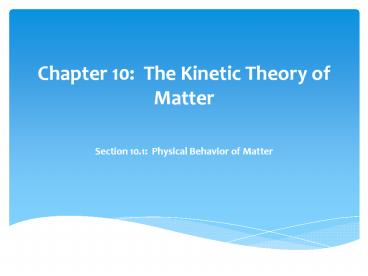Chapter 10: The Kinetic Theory of Matter - PowerPoint PPT Presentation
Title:
Chapter 10: The Kinetic Theory of Matter
Description:
Chapter 10: The Kinetic Theory of Matter Section 10.1: Physical Behavior of Matter Main Idea: The common states of matter are solid, liquid and gas Compare ... – PowerPoint PPT presentation
Number of Views:354
Avg rating:3.0/5.0
Title: Chapter 10: The Kinetic Theory of Matter
1
Chapter 10 The Kinetic Theory of Matter
- Section 10.1 Physical Behavior of Matter
2
- Main Idea The common states of matter are solid,
liquid and gas - Compare characteristics of a solid liquid or gas
- Relate the properties of a solid, liquid, and gas
to the kinetic theory of matter - Distinguish among amorphous solids, liquid
crystals, and plasmas
3
Classification
- Based on properties position and movement of
atoms ions or molecules
4
Solid
- has a fixed volume that cannot be compressed into
a smaller volume - is rigid with a definite shape because the atoms,
ions, or, molecules are in fixed positions
5
Liquid
- is flowing matter with a definite volume but an
indefinite shape - takes the shape of its container
6
Gas
- flowing, compressible matter that has no definite
volume or shape - spreads out to fill the space
- particles are much farther apart than they are in
solids and liquids - particles can be easily pushed together
7
Solid, Liquid and Gas
- Video on states of matter
8
Brownian Motion
- Robert Brown- 1827
- Observed that particles in water (pollen grains)
move continuously in random, irregular directions - Definition constant, random motion of tiny
chunks of matter - https//www.youtube.com/watch?vhy-clLi8gHg
9
Only Water???
- Water molecules are not the only molecules that
display random motion
10
Kinetic Theory of Matter
- states that submicroscopic particles of all
matter are in constant motion - Kinetic energy is the energy of moving objects
11
Kinetic Model of Gases
- A gas particle can change direction only when it
strikes the wall of its container or another gas
particle - Assumptions Each gas particle rebounds without
losing kinetic energy and without losing speed,
but in a new direction - Collisions of particles in a gas are called
elastic collisions because no kinetic energy is
lost
12
Ideal gas
- gas with particles that are in constant motion
but have no attraction for each other. The
particles undergo elastic collisions. - Except at very low temperatures or very high
pressures, nearly all gases act as ideal gases
13
Gas Particles and Pressure
- Pressure is the force acting on a unit area of a
surface Example psi pounds per in2 - Particles in a gas exert a force on each square
cm of the walls of the container when the wall
deflects them - Earths atmosphere (mixture of gases) exerts
pressure also. Constant bombardment of molecules
in the air
14
Kinetic Model of Liquids
- Particles of a liquid can slide past each other,
but they are so close together that they dont
move as straight as gas particles
15
Kinetic Model of Solids
- Strong forces between particles explain the rigid
structure of solids - Particles of a solid cannot move past each other,
but they are in constant motion (vibration) - Particles occupy fixed positions in a well
defined, 3-dimensional arrangement - Crystal lattice- The arrangement, which is
repeated throughout the solid - When a solid melts, its crystal lattices
disintegrate and its particles lose their
3-dimensional pattern
16
- Other forms of matter not classified as solids,
liquids or gases - http//education-portal.com/academy/lesson/the-kin
etic-molecular-theory-properties-of-solids-and-liq
uids.htmllesson
17
Amorphous Solid
- Haphazard, disjointed, and incomplete crystal
lattice - Examples candle wax, cotton candy, peanut butter
- https//www.youtube.com/watch?vbzr-byiSXlA
18
Liquid Crystal
- materials that lose their rigid organization in
only one or two dimensions when they melt - interparticle forces in a liquid crystal are
relatively weak and their arrangement is easily
disrupted - When the lattice is broken, the crystal can flow
like a liquid - Liquid crystal displays (LCDS) are used in
watches, calculators, etc. because they can
change colors at specific temperatures - https//www.youtube.com/watch?vnAJgchCI3kg
19
Plasma
- an ionized gas that forms at very high
temperatures - most common form of matter in the universe but
least common on Earth (sun and stars) - can conduct electrical current and are
electrically neutral (contain equal numbers of
free electrons and positive ions) - are called high-energy states of matter because
high energy is needed to separate and to maintain
separation of the atoms into ions and electrons
20
Bose-Einstein Condensate (BEC)
- Predicted by Einstein in 1924, Created in 1995
(CU Boulder- Cornell/ Weiman) - a rare state (or phase) of matter that occurs at
extremely low temperature, near the value of
absolute zero (at zero- no particles move) - Superfluid helium-4 that involve Bosons
- https//www.youtube.com/watch?vnAGPAb4obs8
21
In the July 14, 1995 issue of Science magazine,
researchers from JILA reported achieving a
temperature far lower than had ever been produced
before and creating an entirely new state of
matter predicted decades ago by Albert Einstein
and Indian physicist Satyendra Nath Bose. Cooling
rubidium atoms to less than 170 billionths of a
degree above absolute zero caused the individual
atoms to condense into a "superatom" behaving as
a single entity. The graphic shows
three-dimensional successive snap shots in time
in which the atoms condensed from less dense red,
yellow and green areas into very dense blue to
white areas. JILA is jointly operated by NIST and
the University of Colorado at Boulder.
22
Stop!
- Highlight vocabulary or unknown words.
- Circle any examples you had written down
- Write 3 questions.

